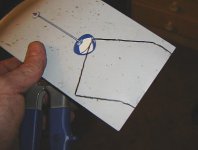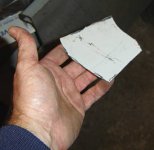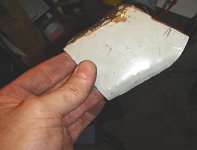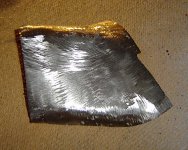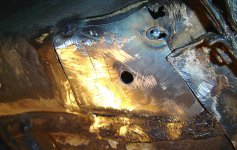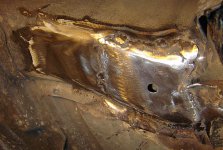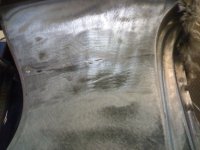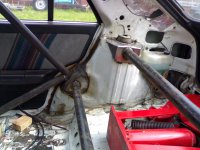Today I fixed a rust hole in my Swift , and hearing the rumor that UNO's might have rust problems too (my UNO doesn't have rust) , I thought that you all would like to see how rust is REALLY fixed.
Below is the hole as enlarged by my friendly yearly vehicle inspection man.

But it really was much bigger.
Rust is always bigger than it looks.

A pattern is made onto paper.....

..and then transfered onto some sheet metal.

The patch is cut.
This will fit INTO the hole with NO OVERLAP in the joints.
Panel beaters will lay a large piece over the rust hole and tack it down here and there , leaving lap joints (that WILL rust) and give a low strength repair.

The patch is carefully bent into shape.

And the paint is removed.

This now fits perfectly into the hole I made.
**again , no lap joints**
Here it is tacked into position.
All edges have been sanded and heavily wire brushed to take away all remaining rust.

It is then fully welded all around.
Any small holes can be filled with weld if required.
After that , I use a flappy sanding disc in the grinder to smooth the welds.

No filler is applied , only a coat of red oxide paint (or your anti rust preference) and two coats of under-body bitumen.
A hole was added so that any water that might enter this section can drain out totally eliminating future rust problems in this section.

Next up to come when this is dry , another coat of bitumen on the outside and some paint sprayed inside and then some rust protection goop. (in through the hole)
Eezy Peezy.
gW
Picture troubles? Try the files directly.
http://www.geocities.com/onegammyleg/temp/fiat/rust01.jpg
http://www.geocities.com/onegammyleg/temp/fiat/rust02.jpg
http://www.geocities.com/onegammyleg/temp/fiat/rust03.jpg
http://www.geocities.com/onegammyleg/temp/fiat/rust04.jpg
http://www.geocities.com/onegammyleg/temp/fiat/rust05.jpg
http://www.geocities.com/onegammyleg/temp/fiat/rust06.jpg
http://www.geocities.com/onegammyleg/temp/fiat/rust07.jpg
http://www.geocities.com/onegammyleg/temp/fiat/rust08.jpg
http://www.geocities.com/onegammyleg/temp/fiat/rust09.jpg
http://www.geocities.com/onegammyleg/temp/fiat/rust10.jpg
Below is the hole as enlarged by my friendly yearly vehicle inspection man.

But it really was much bigger.
Rust is always bigger than it looks.

A pattern is made onto paper.....

..and then transfered onto some sheet metal.

The patch is cut.
This will fit INTO the hole with NO OVERLAP in the joints.
Panel beaters will lay a large piece over the rust hole and tack it down here and there , leaving lap joints (that WILL rust) and give a low strength repair.

The patch is carefully bent into shape.

And the paint is removed.

This now fits perfectly into the hole I made.
**again , no lap joints**
Here it is tacked into position.
All edges have been sanded and heavily wire brushed to take away all remaining rust.

It is then fully welded all around.
Any small holes can be filled with weld if required.
After that , I use a flappy sanding disc in the grinder to smooth the welds.

No filler is applied , only a coat of red oxide paint (or your anti rust preference) and two coats of under-body bitumen.
A hole was added so that any water that might enter this section can drain out totally eliminating future rust problems in this section.

Next up to come when this is dry , another coat of bitumen on the outside and some paint sprayed inside and then some rust protection goop. (in through the hole)
Eezy Peezy.
gW
Picture troubles? Try the files directly.
http://www.geocities.com/onegammyleg/temp/fiat/rust01.jpg
http://www.geocities.com/onegammyleg/temp/fiat/rust02.jpg
http://www.geocities.com/onegammyleg/temp/fiat/rust03.jpg
http://www.geocities.com/onegammyleg/temp/fiat/rust04.jpg
http://www.geocities.com/onegammyleg/temp/fiat/rust05.jpg
http://www.geocities.com/onegammyleg/temp/fiat/rust06.jpg
http://www.geocities.com/onegammyleg/temp/fiat/rust07.jpg
http://www.geocities.com/onegammyleg/temp/fiat/rust08.jpg
http://www.geocities.com/onegammyleg/temp/fiat/rust09.jpg
http://www.geocities.com/onegammyleg/temp/fiat/rust10.jpg
Last edited:




